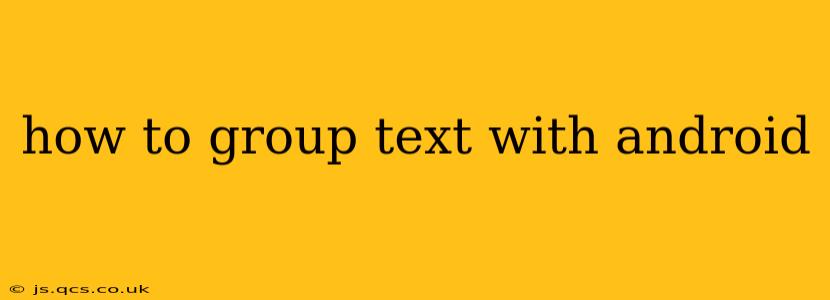Android offers several ways to group text, depending on your specific needs and the context of your application. Whether you're building an app, managing files, or simply organizing your text messages, understanding these techniques is crucial. This guide explores various approaches, from simple formatting to advanced programming techniques.
What do you mean by "grouping text"?
Before we delve into the specifics, let's clarify what "grouping text" means in the Android context. It generally refers to organizing or categorizing text elements for better readability, management, or processing. This can involve:
- Visual grouping: Structuring text using formatting like headings, paragraphs, bullet points, or indentation to enhance readability.
- Logical grouping: Categorizing text into distinct units based on meaning or function, often for data processing or storage. This might involve separating text into different fields or datasets.
- Programmatic grouping: Using programming constructs within Android applications to manage and manipulate text blocks as individual units.
How can I visually group text in my Android app?
Visual grouping is primarily achieved through UI elements and formatting techniques. Here are some key methods:
-
Using layout elements: Android's layout system (using XML or Jetpack Compose) allows you to arrange text within containers like
LinearLayout,RelativeLayout, orConstraintLayout. These containers effectively group text visually by placing it within a defined area. -
Applying styles and themes: Styles and themes in Android allow you to apply consistent formatting to your text, such as font size, color, and indentation. Consistent formatting aids in visual grouping by clearly defining text blocks.
-
Utilizing rich text formatting: Android's
SpannableStringorSpannedclasses allow you to apply different styles (bold, italic, underlined, etc.) to portions of a text string, helping to visually differentiate sections. -
Employing lists: Using
TextViewwith bullet points or numbered lists effectively groups text into easily digestible items.
How can I group text for data processing in my Android app?
Logical grouping for data processing often involves structuring the text data in a more organized manner. Common approaches include:
-
Using data structures: Store text data in structured formats like arrays, lists, or maps. This allows you to access and manipulate individual text segments easily. For instance, an array could hold different paragraphs of text.
-
JSON or XML parsing: If your text data comes from an external source, parsing it into a JSON or XML structure offers a structured way to access and manage individual elements.
-
Regular expressions: Use regular expressions to identify and extract specific text patterns. This can be invaluable for parsing and categorizing text data based on predefined rules.
How do I programmatically group text in Android?
Programmatic grouping, used extensively in app development, involves manipulating text within your code.
-
Using data structures (again): This is crucial for storing and organizing text. You can group sentences, paragraphs, or even characters into different arrays, lists, or custom classes depending on the app’s requirements.
-
String manipulation functions: Android provides numerous string manipulation functions (like
substring(),split(),replace()) that you can leverage to segment and group text programmatically. -
Custom classes: Create custom classes to represent different text groups. For example, a
Paragraphclass could store a title and a list of sentences.
Can I use different apps to group text on Android?
Yes, several Android apps help you group and organize text outside of developing your own applications:
-
Note-taking apps: Many apps allow you to create folders and tags to categorize notes, effectively grouping related text.
-
Document editors: Apps like Google Docs or Microsoft Word offer features like headings, sections, and formatting that facilitate grouping text within documents.
-
File managers: You can create folders to group related text files on your device.
This comprehensive guide provides a solid foundation for understanding and implementing various text grouping techniques on Android. The best approach depends on your specific needs and the context of your application or task. Remember to choose the method that best suits your goal—whether it's improving readability, simplifying data management, or enhancing the functionality of your Android application.
